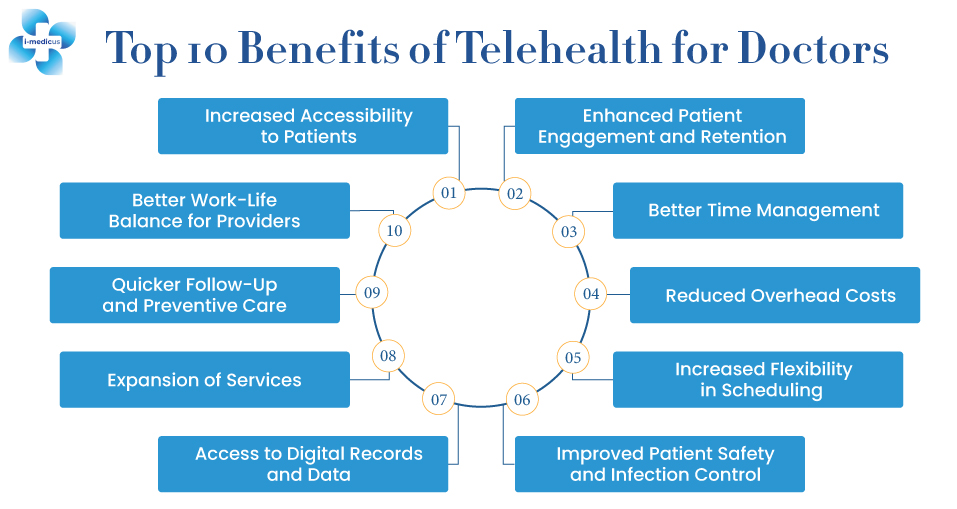Healthcare is a revolutionary idea that has brought a lot of convenience to doctors and patients. It’s a fact that patients can reach out to doctors with convenience and get multiple options rather than approaching a certain limit of doctors. People are unaware of how telehealth platforms benefit doctors and improve their medical practices. These digital systems allow healthcare providers to deliver medical care remotely through video consultations and secure messaging. As well as this, there are numerous benefits that a doctor can receive through telehealth platforms for patients and themselves.
Additionally, it is important to understand what medical professional practices benefit by using the telehealth application. Since new technology is also supporting the variable device, connectivity, and mechanical instrument tracking system but somewhere there are other limitations in the surgical process. However, doctors can consult them and schedule a personal appointment through a telehealth platform to assess the situation. As the healthcare industry becomes more digital, telehealth is becoming a versatile tool for doctors and specialists across disciplines. This blog will explore the top 10 benefits that telehealth platforms provide for healthcare providers, as well as their impact on patient care and revenue generation.
Top 10 Benefits of Telehealth for Doctors

1. Increased Accessibility to Patients
Telehealth means hospitals and healthcare providers can serve patients who live in remote or rural areas where hospitals or other healthcare facilities are not available. Accessibility is greatly improved, and patients get timely care with minimal travel and associated costs. It’s also an opportunity for doctors to grow their practice to a broader patient base without geographic restrictions.
2. Enhanced Patient Engagement and Retention
Telehealth platforms allow healthcare providers to maintain contact with their patients. Telemedicine can be used for follow-up consultation for chronic conditions or to monitor them, but it’s also useful for regular engagement in a patient’s treatment plans for better outcomes and higher retention rates. With virtual consultations being easy, patients are more likely to reach their healthcare provider.
3. Better Time Management
A telemedicine platform has been introduced, which allows doctors to work on the workflows and easily manage appointments. This freed time can be recirculated to focus on providing quality care, less paperwork, less travel, and fewer physical examinations. Digital scheduling systems also help doctors prevent overbooking cuts, cut down on stress, and improve their work-life balance.
4. Reduced Overhead Costs
Doctors and clinics can shift to operational savings by moving to virtual visits. Telehealth reduces dependence on large physical office spaces and corresponds with expenses such as staffing, utilities, and medical supplies. One way to allow for cheaper healthcare options without losing profitability is this.
5. Increased Flexibility in Scheduling
Telehealth offers more flexible appointment options that can help doctors and patients alike. Patients can be seen from anywhere, be it at home or in a clinical setting, which offers higher flexibility in scheduling. It also means that patients can schedule appointments at the times that work for them, and thus, their no-show rates are lower.
6. Improved Patient Safety and Infection Control
Telemedicine enables consultations without physical contact, reduces the danger of infection, and is especially pertinent during pandemics like COVID-19. Virtual care lowers the threat of infectious disease exposure for immunocompromised patients or those at high risk. Healthcare professionals also benefit from this as it reduces their chance of coming into contact with sick patients.
7. Access to Digital Records and Data
Electronic health records (EHR) systems are often built into telehealth platforms. They allow doctors to access patient data in real-time. It makes up-to-date medical history and lab results available to healthcare professionals, which can help them make more informed decisions. Better access to information allows doctors to give better and more accurate diagnoses and personalize more to patients.
8. Expansion of Services
The advantage of telemedicine is that it allows doctors to access a broader range of services. For example, telehealth platforms help patients with mental health consultations, routine checkups, chronic disease management, and remote monitoring, which can all be performed remotely. Not only does this help to increase revenue streams for the healthcare provider, but it also increases the services that the healthcare provider is providing as they meet the different patient’s needs.
9. Quicker Follow-Up and Preventive Care
Telehealth offers greater convenience, as patients can follow up faster and be more consistently monitored regardless of whether they’re making progress or experiencing side effects from treatments. This proactive approach is helpful for preventive care, allowing doctors to identify possible health issues before they escalate. Additionally, this decreases the likelihood of patients being admitted to the hospital and requiring emergency measures.
10. Better Work-Life Balance for Providers
Telehealth platforms allow healthcare providers to maintain a good work-life balance. Less time spent moving from one place to another means that doctors spend extra time with their families or learning about their line of specialty. The advantage of telemedicine’s flexibility is that it allows healthcare providers to organize their work schedules better.
Read Also: Pros and Cons of Telehealth for Doctors
What Kinds of Medical Concerns Work Best for Telemedicine?
While telehealth can address a broad range of medical concerns, it is particularly suited to certain types of care, including:
- Chronic Condition Management
Diabetes, hypertension, or asthmatic patients, for instance, can consult with their doctors through telemedicine at their own convenience. It minimizes their disease management without constantly visiting the clinic. It is excellent for those who are busy or have some mobility issues.
- Cold and Flu Symptoms
Telemedicine is quite useful for simple conditions like colds or flu. However, other conditions cannot be diagnosed through telemedicine. Also, through an app, doctors can diagnose symptoms and recommend appropriate treatment or even prescribe drugs. This saves time and time-consuming journeys to the clinic, especially when no health problem is found.
- Mental Health Support
Some consulting is provided by video calls. Patients and the counselor can feel comfortable, and no one interferes with the conversation. Patients are able to get mental health services from the comfort of their homes, and this is less stressful.
- Skin Conditions
It permits patients to present skin conditions such as rash or acne through a video call. Patients do not need to go to the doctors’ offices, so those who are not emergencies can avoid time wastage.
- Prescription Refills
Telemedicine allows for easy review and renewal of daily prescriptions, preventing unnecessary visits to clinics. Doctors assess their patients’ requirements and order renewal prescriptions for drugs so that patients can easily get them.
Impact of Telehealth Platforms in Generating Revenue
Telehealth applications influence reimbursement models for service providers positively by increasing access to more clients and increasing efficiency in the delivery of services. Through telephonic consultation, the providers can manage to reach the patients who may have limited mobility to move around, some physical constraints, or time-related issues. Up to this point, this is convenient and, most of the time comes with the advantage of enhanced patient turnout and loyalty. Thirdly, telehealth services may also decrease the overhead costs of face-to-face consultations since there is no need to hire employees to attend to the various offices regularly.
The flexibility that is associated with scheduling and monitoring can improve efficiency in that more patients can be attended to in a shorter time. Furthermore, billing systems integrated with many telehealth solutions enhance payment selling, which enhances the chances of timely payments. Telemedicine is becoming popular day by day; the healthcare establishments that use the benefits of telehealth can have additional income, attract more clients, and financially develop using telehealth, which will be beneficial for the existence and evolution of practices.
Conclusion
Telehealth platforms have long become beneficial for healthcare providers, aiding patient access and enhanced organization, among other aspects. They review, treat extended illnesses, improve mental health, and do post-admittance checkups; they revolutionize care provision. Aside from the customer advantage, this mode of service delivery reduces overhead expenses and increases revenue through an expanded clientele base and service offering. As the use of digital health increases, telehealth is a permanent part of the modern healthcare systems that provide high-quality healthcare services to patients and physicians. Telemedicine also opens a great opportunity for healthcare specialists to improve their professional practices and remain relevant in the digital environment.
FAQs
Q1 What types of services can I access through telehealth?
You can access services like virtual consultations for chronic conditions, mental health support, follow-ups, and dermatological evaluations. Many platforms also offer prescription refills and lab result reviews.
Q2 How does telehealth ensure patient privacy and security?
Telehealth platforms protect patient information using encryption and secure connections. They comply with regulations like HIPAA, ensuring your health data remains confidential during virtual visits.
Q3 Do I need special equipment to use telehealth services?
Most telehealth services require a smartphone, tablet, or computer with internet access and a camera. Some platforms may have specific app requirements, but they are generally user-friendly.
Q4 Will my insurance cover telehealth visits?
Due to recent regulatory changes, many insurance plans now cover telehealth services. However, coverage can vary by provider, so check with your insurance company for specifics.
Q5 How do I prepare for a telehealth appointment?
To prepare, ensure you have a quiet, private space. Test your device’s camera and microphone, and have necessary medical information, like medications or health history, ready to discuss.








